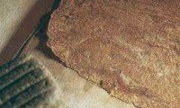Difference between revisions of "Amatl"
Jump to navigation
Jump to search
(username removed) |
|||
| Line 4: | Line 4: | ||
Paper made by the Aztecs from bast fibers of ''Ficus'' trees, such as ''Ficus petolaris''. The fibers scraped from inside the bark are boiled, then beaten and felted into sheets. They were often polished with stones to produce a smooth surface. Other sources have used this name to describe paper made from majirey cactus fibers (Sahgum 1963) and from mulberry trees fibers (Lenz 1961). | Paper made by the Aztecs from bast fibers of ''Ficus'' trees, such as ''Ficus petolaris''. The fibers scraped from inside the bark are boiled, then beaten and felted into sheets. They were often polished with stones to produce a smooth surface. Other sources have used this name to describe paper made from majirey cactus fibers (Sahgum 1963) and from mulberry trees fibers (Lenz 1961). | ||
| − | See also [ | + | See also [[amate|amate]]. |
== Synonyms and Related Terms == | == Synonyms and Related Terms == | ||
Revision as of 12:54, 7 January 2014
Description
Paper made by the Aztecs from bast fibers of Ficus trees, such as Ficus petolaris. The fibers scraped from inside the bark are boiled, then beaten and felted into sheets. They were often polished with stones to produce a smooth surface. Other sources have used this name to describe paper made from majirey cactus fibers (Sahgum 1963) and from mulberry trees fibers (Lenz 1961).
See also Amate.
Synonyms and Related Terms
amate; Aztec paper; Nahuatl
Additional Information
° Sylvia Rodgers Albro and Thomas C. Albro. "The examination and conservation treatment of the Library of Congress Harkness 1531 Huejotzingo Codex." JAIC, 29(2), pp. 97-115, 1990. (Link)
Authority
- G.S.Brady, Materials Handbook, McGraw-Hill Book Co., New York, 1971 Comment: p. 574
- Book and Paper Group, Paper Conservation Catalog, AIC, 1984, 1989
- Silvie Turner, Which Paper?, Design Press, New York, 1991
